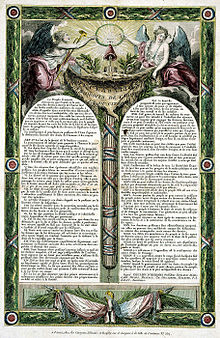- Declaration of the Rights of Man and Citizen of 1793
-
The Declaration of the Rights of Man and Citizen of 1793 (French: Déclaration des droits de l'Homme et du citoyen de 1793) is a French political document. It was written by the commission that included Louis Antoine Léon de Saint-Just and Marie-Jean Hérault de Séchelles during the period of the French Revolution. The main distinction between the Declaration of 1793 and the Declaration of the Rights of Man and of the Citizen of 1789 is its egalitarian tendency: equality is the prevailing right in this declaration.
The text is often said to have been mainly written by Hérault de Séchelle, whose style and writing can be found on most of the documents of the commission that also wrote the French Constitution of 1793 ("Constitution of the Year I") that was never applied, but whose application was steadfastly demanded by the French left until the beginning of the 20th century.[citation needed]
The first project of the Constitution of the French Fourth Republic also referred to this version of the Declaration of the Rights of Man and Citizen.
Contents
Equality as the first natural right of man
Equality is the most important aspect of the Declaration of 1793. In its second article, equality is the first right mentioned (followed by liberty, security, and property). In Article 3 states "All men are equal by nature and before the law". As such, for the authors of this declaration equality is not only before the law but it is also a natural right, that is to say, a fact of nature.
There was already at that time a school of thought that stated that liberty and equality can quickly become contradictory: indeed liberty doesn't solve social inequalities since there exist some natural inequalities (of talent, intelligence, etc.). That school of thought considered that the government had only to protect liberty and to only proclaim natural equality, and eventually liberty would prevail over social equality since all people have different talents and abilities and are free to exercise them. The question raised by this declaration is how to solve social inequalities. Article 21 states that every citizen has a right to public help, that society is indebted to each citizen and therefore has the duty to help them. Citizens have there a right to work and society has a duty to provide relief to those who cannot work. Article 22 declares a right to education.
These rights are considered "2nd generation rights of Man", economical and social rights (the first ones would be natural or political). These rights entail a greater government intervention in order to reach society's goal, stated in article 1: common welfare.
The protections of Liberty
Individual liberty is still a primary right and some aspects are more precisely defined than in Declaration of 1789. The declaration explicitly states the freedom of religion, of assembly and of the press (article 7), of commerce (article 17), of petition (article 32). It also prohibits slavery (article 18) "Every man can contract his services and his time, but he cannot sell himself nor be sold: his person is not an alienable property."and accordingly.
The protections of the citizens against their own government
If in a way, this declaration has a more liberal bend in the modern American sense since it states that there ought to be public policies for the general welfare, it also contains some very strong libertarian aspects.
Article 7 states "The necessity of enunciating these rights supposes either the presence or the fresh recollection of despotism." Article 9: "The law ought to protect public and personal liberty against the oppression of those who govern." Article 33 states that resisting tyranny is a logical consequence of the rights of man: "Resistance to oppression is the consequence of the other rights of man". Article 34 states that if one is oppressed, everyone is. Article 27 states "Let any person who may usurp the sovereignty be instantly put to death by free men." Though the usurpation of sovereignty is not detailed, sovereignty is explained in article 25 as residing "in the people". There is no doubt that this way of thinking deeply influenced the revolutionary government during the Terror.
Finally, article 35 states "When the government violates the rights of the people, insurrection is for the people and for each portion of the people the most sacred of rights and the most indispensable of duties." Though this declaration was never enforced (like the Constitution of the First Republic), History has shown that the French people has followed this advice with many successful (1830, 1848) and unsuccessful (1870) revolutions throughout the 19th century.
External links
Categories:- 1793 in law
- 1793 events of the French Revolution
- French law
- History of human rights
- Human rights in France
- Government of France
- Political charters
Wikimedia Foundation. 2010.

